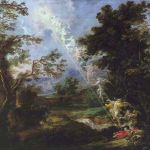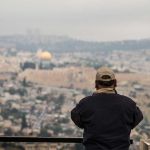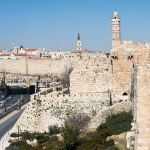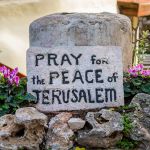“I have posted watchmen on your walls, Jerusalem; they will never be silent day or night. You who call on the Lord, give yourselves no rest, and give Him no rest till He establishes Jerusalem and makes her the praise of the earth.” (Isaiah 62:6–7)
“It is high and magnificent; the whole earth rejoices to see it! Mount Zion, the holy mountain, is the city of the great King!” (Psalm 48:2)
King David made Jerusalem the capital of Israel almost 3,000 years ago. Ever since, the city has played a central role in Jewish life, even after the city was sacked and the Temple was destroyed in AD 70 by the Romans.
Jewish prayers underline this central role and the holiness of Jerusalem. For instance, the Amidah, which is recited three times every weekday, is prayed facing Jerusalem.
These lines are part of the Amidah:
“And to Jerusalem, Your city, may You return in compassion, and may You rest within it, as You have spoke. May You rebuild it soon in our days as an eternal structure, and may You speedily establish the throne of King David within it. Blessed are You, God, the builder of Jerusalem…. May our eyes behold Your return to Zion in compassion. Blessed are you God, who restores His presence to Zion.”
This theme is also found in Grace After Meals, the prayer recited after eating a meal with bread:
“Have mercy Lord, our God … on Jerusalem Your city, on Zion the resting place of Your glory, on the monarchy of King David Your anointed, and on the great and holy Temple upon which Your name is called…. Rebuild Jerusalem, the holy city, soon in our days. Blessed are you God who rebuilds Jerusalem in His mercy, amen.”
The blessing recited after eating a light meal also includes reference to rebuilding Jerusalem and the Holy Temple:
“Have mercy, Lord, our God … on Jerusalem, Your city; and on Zion, the resting place of Your glory; upon Your altar, and upon Your Temple. Rebuild Jerusalem, the city of holiness, speedily in our days. Bring us up into it and gladden us in its rebuilding and let us eat from its fruit and be satisfied with its goodness and bless You upon it in holiness and purity.”
For thousands of years, Jews have prayed for Jerusalem and repeated the oath, “If I forget thee, O Jerusalem, let my right hand forget her cunning.” (Psalm 137:5)

A Jewish man recites morning prayers at the Western (Wailing) Wall, which is located at the foot of the Temple Mount in Jerusalem. He is wearing tefillin (phylacteries) and a tallit (prayer shawl). (Photo credit: Go Israel, Noam Chen)
David Conquers Jerusalem
“For the LORD has chosen Zion, He has desired it for His dwelling, saying, ‘This is My resting place for ever and ever; here I will sit enthroned, for I have desired it.’” (Psalm 132:13–14)
Just before the Israelites crossed the Jordan to enter the Promised Land, the Lord promised that He would choose a place for His name to live.
There, in that holy place, the people were to meet the LORD three times a year. (Deuteronomy 12:1–11).
“Then to the place the Lord your God will choose as a dwelling for His Name—there you are to bring everything I command you: your burnt offerings and sacrifices, your tithes and special gifts, and all the choice possessions you have vowed to the Lord.” (Deuteronomy 12:11)
“Three times a year all your men must appear before the LORD your God at the place He will choose….” (Deuteronomy 16:16)
Several times, God confirmed that He had chosen the Temple Mount (Mount Moriah) in Jerusalem on which Solomon dedicated the Temple as the site where He would place His name (1 Kings 8:28–29; see also 2 Chronicles 6:20, 33–34, 38; Psalm 78:67–69; 132:13–14).
For about 400 years, however, God did not reveal to the Jewish People where He would place His name; nevertheless, 37-year-old King David chose Jerusalem for a capital, after reigning over Israel for seven years from the city of Hebron.
He captured Jerusalem from the neighboring Jebusites, even though it wasn’t located on a major trade route or the sea or even on a river, which would have been perhaps a more logical location.
Some speculate that David chose this city for the capital because it had yet to be conquered. Therefore, it was politically neutral within the 12 tribes, even though it falls within the land allotments for the Tribe of Benjamin and the Tribe of Judah.
He captured ancient Jerusalem using a vulnerability in the water shaft of the Gihon Spring, which emerged from a cave above the Kidron Valley on the eastern slope of what would come to be known as the City of David. From there, water flowed into the valley (2 Samuel 5:8).
“David then took up residence in the fortress and called it the City of David. He built up the area around it, from the terraces inward.” (2 Samuel 5:9–10)

At the City of David in Jerusalem, Israel has uncovered the ruins of the impressive Canaanite fortress that once protected the city and guarded the precious Gihon Spring.
The Gihon Spring: Jerusalem’s Only Water Supply
The Gihon Spring, whose name comes from the Hebrew verb “to gush forth,” is the only natural source of water in Jerusalem. It draws water from an underground cave that fills with groundwater accumulating from the rain and snow of Israel’s winters.
At the point of capacity, the Gihon empties through cracks in the rock and the water siphons to the surface. The Israelites used pools and cisterns to collect the overflow, which was a common method of storing water.
That water ebbed and flowed throughout the day, the frequency depending upon the season. But a consistent supply of water is the usual requisite for an arid city to survive and expand successfully.
To overcome this shortcoming, ingenious systems were designed to aid collection of water and cause it to flow upward.
“The complex water system under the ancient city of Jerusalem includes not only a maze of tunnels, but also walls—walls that served as dams, raising the level of the water. One of the walls … blocked the water from flowing directly out into the Kidron Valley at the Gihon Spring, and instead, steadily raised the water level” until it “flowed into the tunnel,” states Avraham Faust in “Warren’s Shaft, Yes, It Really Was Used to Draw Water.” (Biblical Archaeology Review)

This photo of Solomon’s Pools, part of an ancient waterway supplying water to Jerusalem, was taken between 1890 and 1905. The pools are located 5 kilometers (3.1 mi) southwest of Bethlehem and are thought to have provided water to the Temple Mount.
Solomon’s Pools
David’s son Solomon was anointed as king at the Gihon Spring at King David’s order. The Temple that he built required large amounts of water for “bathing and ritual immersion, rinsing animal sacrifices and cleaning sacrificial blood.” (Temple Mount)
It is believed that Solomon constructed a complex aqueduct system from Hebron to Jerusalem in 950 BC. This system along with the many cisterns that collected rain water supplied the priests with much of the Temple’s water supply.
Evidence of the Upper Aqueduct (which might have ended at Hezekiah’s Pool) and Lower Aqueduct (which supplied the Temple Mount) still exists. Water from this system of aqueducts was found to be still flowing in 1967.
Although some attribute the construction of this system to Solomon, others date the earliest phase of the construction of the Lower Aqueduct to the Hasmonean era (140 BC–37 BC).
Hezekiah’s Tunnel
“It was Hezekiah who blocked the upper outlet of the Gihon Spring and channeled the water down to the west side of the City of David. He succeeded in everything he undertook.” (2 Chronicles 32:30; see also 2 Kings 20:20)
In times of war, the water supply beyond Jerusalem’s walls would be a point of weakness for the city, which would fall under siege more than a dozen times.
The Bible tells us that King Hezekiah (715–686 BC) sought a method of securing the Gihon so that Jerusalem’s water supply was not vulnerable to being cut off during the siege of the Assyrian king, Sennacherib (701 BC).
He dammed up the waters and cut a channel through the Ophel (the City of David, the eastern hill of the city) to the Pool of Siloam (2 Chronicles 32:30).
The 1,760 foot [536 m] tunnel is a marvel of the engineering methods of Hezekiah’s age. Two teams of laborers started at opposite ends and met in the middle.

The Shiloah (Siloam or Silwan) inscription, which was written 2,700 years ago during the reign of King Hezekiah, states that the work on the tunnel began at both ends simultaneously and proceeded until the stonecutters met in the middle. It was discovered inside the Hezekiah tunnel, which brings water from the Gihon Spring to the Pool of Siloam, located in the City of David in the Jerusalem neighborhood of Shiloah.
Today, a tour of the tunnels is considered a highlight of any visit to the ancient City of David—a kind of Indiana Jones adventure.
“As visitors slosh through the water, their flashlights pick up the marks of the ancient pickaxes, going in one direction until the meeting point and then going the other way. The water-walk takes about 45 minutes, and is recommended for visitors of all ages tall enough to wade through about two feet of flowing water” .
“For land-lubbers, new excavations have revealed another tunnel, now dry but that still gives a sense of the greatness of Jerusalem’s long ago laborers, monarchs and engineers” .
The Prophecy of Living Waters
“The Lord says to my lord: ‘Sit at my right hand until I make your enemies a footstool for your feet.’ The Lord will extend your mighty scepter from Zion, saying, ‘Rule in the midst of your enemies!'” (Psalm 110:1–2)
Of all the waters that flow in Jerusalem, the most impressive are the prophesied Living Waters that will flow from the Temple to come, at the dawn of the Messianic era when Yeshua (Jesus) returns.
On that day, the Lord will return to fight against the nations who gather against Jerusalem in battle (Zechariah 14:4).
While Jerusalem’s Gihon continues to refresh the people, the Prophet Zechariah promises a glorious, abundant source of Living Water.
“On that day Living Water will flow out from Jerusalem, half of it east to the Dead Sea and half of it west to the Mediterranean Sea, in summer and in winter. The LORD will be king over the whole earth. On that day there will be one LORD, and His name the only name.” (Zechariah 14:8–9)

A tourist who exited exited Hezekiah’s Tunnel at the Pool of Siloam found local Arab children playing in the water that originates at the Gihon Spring.
The Prophet Ezekiel also had a vision of Jerusalem’s Living Water. He foresaw at the entrance of the rebuilt Temple “water coming out from under the threshold of the temple toward the east” and “from under the south side of the temple, south of the altar.” (Ezekiel 47:1–2)
Of course, Believers in Yeshua already have the privilege of experiencing the Living Waters that flow from the indwelling of the Ruach HaKodesh (Holy Spirit).
“Yeshua stood and said in a loud voice, ‘Let anyone who is thirsty come to Me and drink. Whoever believes in Me, as Scripture has said, rivers of living water will flow from within them.’ By this He meant the Spirit, whom those who believed in Him were later to receive.” (John 7:37–39)
While Yeshua is preparing a place for us in Heaven, we can experience His presence daily because His Ruach (Spirit) lives in us.
The Word of God also promises that in the Last Days, there will be a great outpouring of the Ruach HaKodesh (Holy Spirit) and that the Jewish People will understand that Yeshua is the promised Messiah and be saved. (Zechariah 12:10–12)
And when He returns, Jerusalem’s water will be miraculously transformed into a real-life illustration of our ever-faithful King, who is Himself the fount of Living Water pouring out from the heights of Jerusalem into the world.
““For out of Zion shall go forth the law, and the word of the Lord from Jerusalem.” (Isaiah 2:3)





























